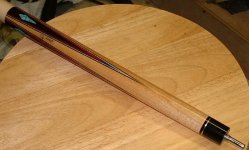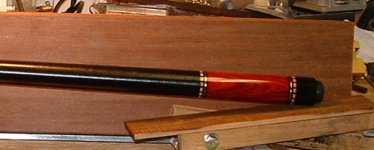That's the million dollar question, that I still need answers to Myself. I asked once before and someone posted a search like this one
http://www.google.com/search?q=2+part+wood+sealer+cocobolo&hl=en&lr=&start=10&sa=N I have tried a few things, but for one reason or another was not satisfied. The spar sealed it off well but turned It somewhat antique, and i did'nt think it was going to ever dry. I'm talking weeks not hours, so I definatly don't recomend it..
Cleaners I have used are thinner, acetone, denatered alcohol, and water depending on what surface I was cleaning. no water on bare wood obviously, but also have to be carefull with the others on some plastics or composites, or you can melt them. I would recomend whatever you use to always try it on something like scrap if it's possible, because different materials react in different ways to cleaners, and I imagine the same goes with finishes, so I'm hesitent in recomending any. With coco cleaning can be tricky also, if you have any white areas it is possible that wiping the coco over them can stain, just like when sanding. It's like Mike mentioned in the other thread, there are just so many little things that can go wrong or be a PITA, and It's really hard to lay them all out for someone, and not miss something somewhere, and they are just things that unfortuanately are usually learned the hardway. I'm still learning many of those Myself, and everytime I try something different it switches things up on Me again.
On the water bourne, altough I have used some decent ones refinishing cabinets in the past, and have heard of some that are suppose to be very durable, but the only water base I used on a cue was just a harware store water based poly that I tried on a cue one time that was'nt even coco, it was only a refinish on stained birdseye. It looked decent when done, but months later I could see some bubbling effect taking place in parts of the finish, and the only thing I can figure is the stain that was originally used must have been an oil based, because the other areas of the cue that were not stained, did not bubble, so the oils in the coco may make that worse depending on the actual product used, and that's if You don't have problems even before completing the finish. I would not think that going straight over coco with it would be a good thing, but posible with a good sealer you could. I really don't know for sure though.
On the cue I mentioned, I used a spar urethane, and like I mentioned it took a while to dry, but eventually did, and then I went over it with a deft Lacquer. Both were in spray bomb, because of My lack of a spray booth to spray auto clear. The result, well, the spar sealed everything off and stuck very well once it finally dried, and the deft was easier to sand and buff then water based or ca I have used. The finish was a decent one for spray bombs, but it had some antiqueing color to it from the spar, (not the deft as it's clear), that some might would not like, and it could have been a slight bit harder. It's more of an old school look to me. I'll include a couple of pics, one is of the front before wrap, and the other of the butt after wrap, which is where the spar did'nt want to dry on the coco. They're not very good pics and don't show very well, but should give the idea.
I must have been nuts to try this, but I wanted to shoot with the cue & a shelac sealer on this cue just was'nt getting it for me. It's not the same as a auto clear, but seemed to work well enough to seal the cue off good so I could use it until I'm setup to spray, altough I would'nt sell a cue with this finish. keep in mind this is'nt something i recomend, just something I did. I am going to start spraying auto finish, so what I still need is a good sealer. I have heard of a west epoxy as a sealer, but have heard rumors of yellowing or antiqueing with that as well. If someone knows of a type of west product that would be good as sealer, and stays clear I for one would forever be in their dept.

I can just run down the street to buy west products here in town.
My opinion, for an easy to work with, durable, as well as good looking finsh, the best way to go is a good autofinish. You need something for a good grain filler possibly the correct sealer may help in the area, but a good sealer will be a must anyway, and that's one thing i still need to find. You need a good spray booth with ventlation, and the proper breathing setup to be safe. There are other ways, but i think that's the way I'm going. Good luck with it, hopfully someone with more experience in this area can recomend a good sealer.

Greg

